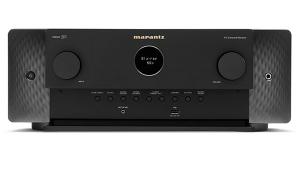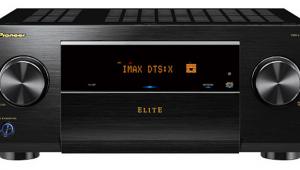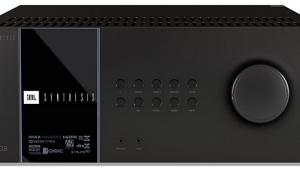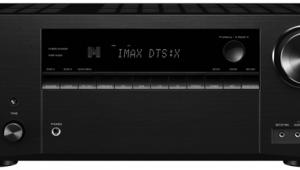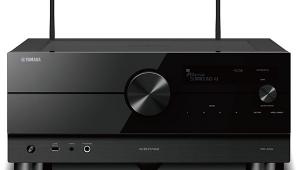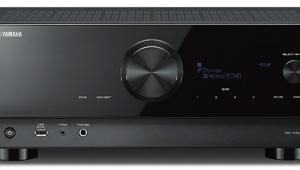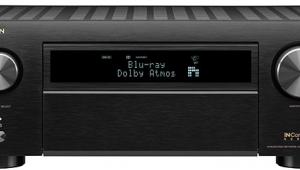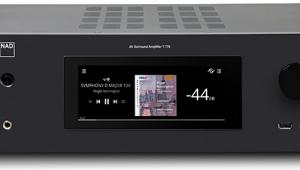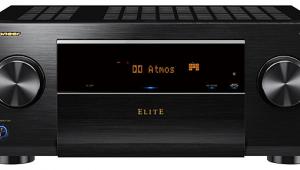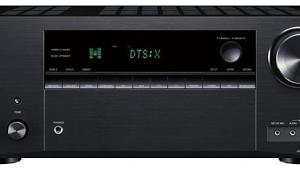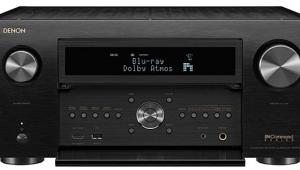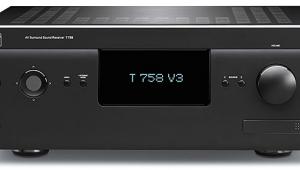Yamaha Aventage RX-A2040 AV Receiver Review Page 2
Music and Movies
As usual, I started my evaluation by treating the RX-A2040 like a simple two-channel audiophile amp. Then I gradually brought in its additional capabilities using multichannel music and movies, but only after I had a handle on its basic sound. To that end, I started by playing “Dona Maria” from jazz bassist Rufus Reid’s Out Front, using the Pure Direct mode with no subwoofer. On this recording, Reid’s instrument has a rich and fat sound, but through the RX-A2040, there was a fine sense of clarity that made it easy to follow the melody of his bass line. Drummer Duduka Da Fonseca kind of goes wild at one point, but I was struck by how easy it was to hear the contrasts in tonal colors between the various cymbals in his kit. Overall, the tonal balance tended to fall very slightly on the warm and full side of neutral, but with a clarity in the upper midrange that allowed the various players to cut through when it was their turn in the spotlight.
 To check out the Yamaha’s abilities with hi-res music, I connected my laptop via the front-panel USB port to play 192-kilohertz/24-bit downloads from HDtracks.com of “Wood and Metal” and “War” from Explorations in Space and Time featuring Jamey Haddad, Lenny White, and Mark Sherman. These three renowned percussionists really let it rip, and the simple two-microphone recording from Chesky truly demonstrates what real dynamics are. The first track features the quiet rustle of a rain stick and wood blocks, but this contrasts dramatically with the massive pounding of huge bass drums and gongs on “War.” The RX-A2040 took these extreme dynamic demands in stride, allowing all of the tonal color and subtlety of each instrument and the recording space itself to shine through clearly.
To check out the Yamaha’s abilities with hi-res music, I connected my laptop via the front-panel USB port to play 192-kilohertz/24-bit downloads from HDtracks.com of “Wood and Metal” and “War” from Explorations in Space and Time featuring Jamey Haddad, Lenny White, and Mark Sherman. These three renowned percussionists really let it rip, and the simple two-microphone recording from Chesky truly demonstrates what real dynamics are. The first track features the quiet rustle of a rain stick and wood blocks, but this contrasts dramatically with the massive pounding of huge bass drums and gongs on “War.” The RX-A2040 took these extreme dynamic demands in stride, allowing all of the tonal color and subtlety of each instrument and the recording space itself to shine through clearly.
Even with just two speakers playing, James Newton Howard’s score for After Earth has the type of huge and enveloping sound that makes you wonder why we need surround sound at all. The movie may have been a flop, but this soundtrack is a winner in the epic-science-fiction-thriller model, with huge kettledrums, sweeping strings, and speaker-crushing dynamics. I played the opening track, “The History of Man,” with peak volume levels at my listening seat reaching 104 decibels, and the RX-A2040 never broke a sweat. The dynamics didn’t sound compressed in any way. The recording may have been artificially tweaked and poked in the studio to give it such a huge sound, but there’s no denying the excitement it creates when played through a system with enough power to deliver the dynamic swings required.
Next, I moved on to surround music with the Blu-ray of Peter Gabriel’s Back to Front: Live in London and played “Red Rain.” The sound here puts you right in the O2 Arena, surrounded by Peter and the band. Gabriel’s concerts usually involve a lot of different musicians, which could lead to a sense of dynamic congestion, but through the RX-A2040, even little details like the marimba, the triangle, and the cello player’s bow on the strings cut through the mix clearly. As before, the overall sound was warm and enveloping, yet detailed without being overtly bright.
Home theaters are made for movies, so last but certainly not least, I ran the RX-A2040 through some of my favorite movie test material in surround, starting with the Blu-ray of RED. Near the opening, there’s a scene where a SWAT team goes after Frank Moses (Bruce Willis) in his home, accompanied by a soundtrack that combines pumping, synthesized techno music with a seemingly endless stream of gunshots and explosions. Despite the dramatic dynamic impact of each shot, there was a sense of ease to the way the RX-A2040 presented everything, letting you hear the different timbre of the retorts from each weapon and the wood frame of the house it was firing through, rather than just a confusing cacophony of high-frequency sound. At one point, Moses drops some bullets into a heated frying pan, letting the stove set them off randomly to create a sonic distraction. Through the Yamaha and PSBs, the distraction became real, with the sound of bullets whizzing everywhere around my room.

For some subtler movie effects, I put on the opening scene of Source Code, where Colter Stevens (Jake Gyllenhaal) is on a train, trying to figure out who he is. The clarity of the Yamaha’s presentation revealed the care put into the sound mix, making small details easy to discern, such as the way the sound of the wheels clattering on the tracks under the train changes as Stevens moves from the main passenger car to the bathroom. Dialogue clarity was always exceptional, even when the strings in the score swell up to envelope the soundstage. Of course, all hell breaks loose when the train explodes, but even then the resulting sound was powerful and authoritative, rather than just loud.
Conclusion
The Yamaha RX-A2040 gives you pretty much everything you would expect from a big, near-flagship receiver. It can handle music and movies from just about any type of format or source you can throw at it—and reproduce it all with a fine combination of warmth, clarity, and timbral transparency. The supplied remote is nothing to write home about, but I found it was easy to simply control the receiver with an iPad running Yamaha’s iOS app.
The big elephant in the room, however, is that just like most other recent AV receivers, the RX-A2040 can’t handle the HDCP 2.2–protected Ultra HD signals that are slated to be coming down the pike soon. If UHD (4K) video isn’t important to you, then this won’t be a problem—but if it is, you eventually may need to find a way to route UHD video sources around the Yamaha while running a separate link for the audio. This caveat aside, the RX-A2040 needs no excuses, and it can kick butt in any top-notch setup.
